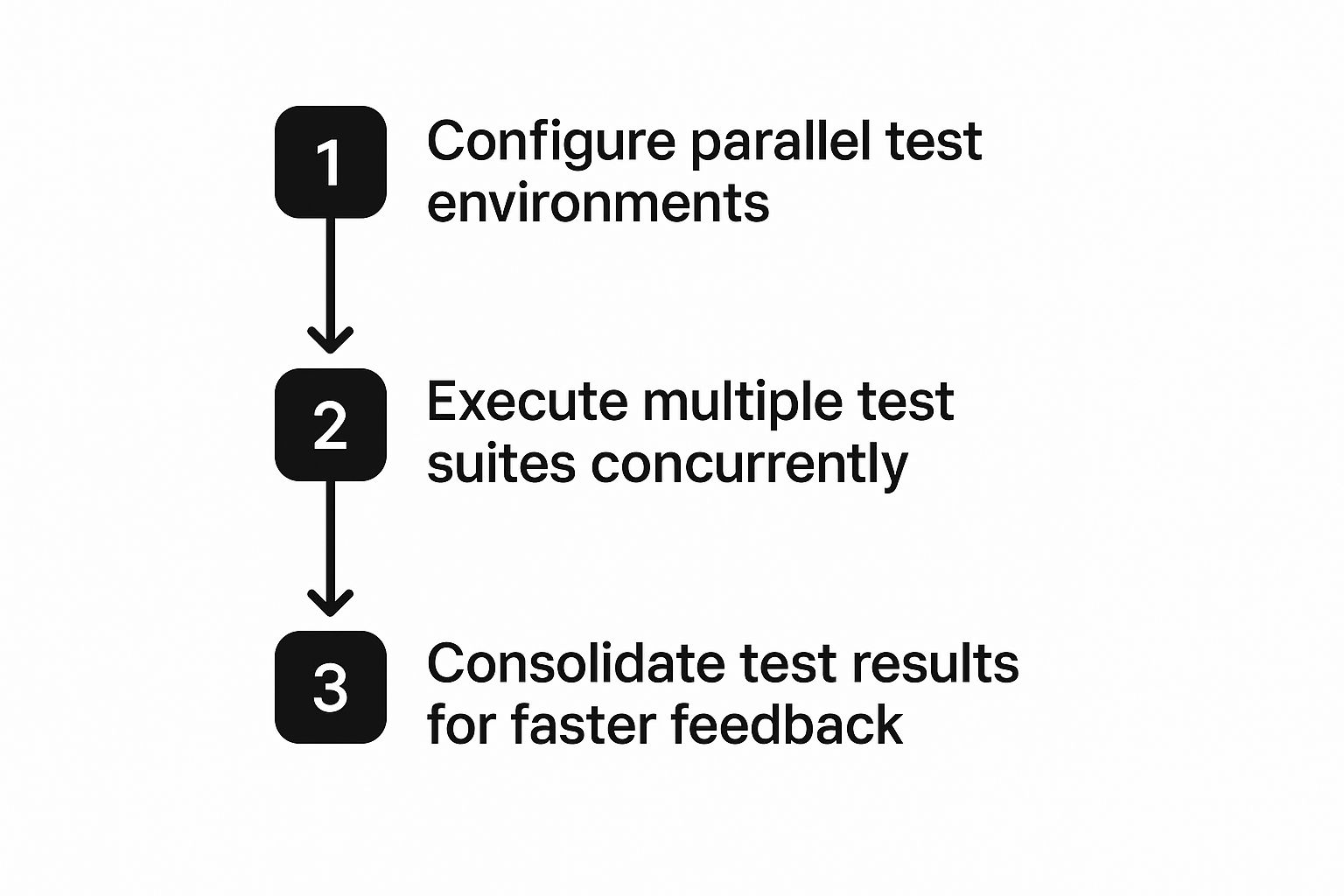A Guide to Testing in Parallel with dotMock
Running multiple automated tests at the same time, instead of one by one, is what we call parallel testing. This isn't just a fancy trick; it’s a strategy that drastically cuts down feedback time in your CI/CD pipelines. Ultimately, it helps development teams find and squash bugs much, much faster.
Why Testing in Parallel Is a Non-Negotiable Skill

In today's fast-paced development world, waiting for tests to run sequentially is a major bottleneck. Think about it: it's like a long queue where each test has to wait for the one ahead to finish. If just one of those tests is slow, the entire process grinds to a halt, delaying critical feedback and killing developer momentum. This old-school, linear approach just can't keep up anymore.
Parallel testing completely changes the game. It breaks up that single queue and runs independent tests at the same time across different environments. Instead of one long line, you now have multiple checkout lanes open. The result? A massive reduction in the total time it takes to run your test suite. A process that used to drag on for an hour could be done in just a few minutes.
A Quick Look at the Difference
To see how profound this shift is, let’s compare the two approaches side-by-side.
| Aspect | Sequential Testing | Parallel Testing |
|---|---|---|
| Execution | One test runs at a time, in a specific order. | Multiple tests run simultaneously. |
| Speed | Slow. Total time is the sum of all individual test durations. | Fast. Total time is determined by the longest single test. |
| Feedback Loop | Long. Developers wait a significant time for results. | Short. Developers get feedback almost instantly. |
| Resource Use | Inefficient. Only a fraction of available resources are used. | Efficient. Maximizes the use of available infrastructure. |
Moving to a parallel model is a fundamental change that directly impacts your team's ability to ship code quickly and confidently.
The Business Case for Speed
Getting feedback faster isn't just a nice-to-have for developers; it’s a real competitive advantage for the business. The global automated testing market, which is built on the foundation of parallel execution, was valued at USD 28.1 billion in 2023 and is expected to nearly double by 2028. This isn't just a trend—it's an industry-wide recognition that speed and quality must go hand-in-hand.
Adopting this approach delivers some serious wins:
- Faster CI/CD Pipelines: When tests run quicker, so do your builds. This means you can deploy new features and fixes more often.
- More Productive Developers: Quick feedback loops mean developers can iterate on their code without the frustrating stop-and-start of waiting for tests.
- Better Use of Resources: Your CI/CD infrastructure is put to much better use, running more tests in a shorter amount of time.
The core idea is simple: your pipeline can only be as fast as its slowest part. Parallelism breaks that slow part into many smaller, faster jobs, completely rewriting the speed equation.
The Role of Mocking and Isolation
Of course, running tons of tests at once introduces its own set of challenges, especially when dealing with external API dependencies. If you have multiple tests all hitting the same live third-party service, they can easily step on each other's toes, leading to flaky results, rate-limiting errors, or worse.
This is exactly where API mocking becomes essential. By swapping out real, unpredictable APIs with stable, virtualized endpoints, you give each test its own clean, isolated sandbox to play in. Tools like dotMock are designed for this, giving you the control and stability needed for reliable parallel testing. You can simulate any scenario—success, failure, or slow response—without ever touching an external service.
This strategy is a key application of the concepts behind https://dotmock.com/blog/what-is-service-virtualization. It transforms your testing process from a fragile, dependency-riddled headache into a resilient and scalable engine for building quality software.
Getting Your dotMock Environment Ready for Parallel Runs
Jumping into parallel testing without laying the proper groundwork is a surefire way to get flaky, unreliable results. Before you can reap the rewards of faster feedback loops, you need to make sure your environment can handle multiple tests running at the same time without tripping over each other. The goal here is simple: every single test thread needs its own isolated sandbox.
The number one problem I see with parallel testing is state contamination. This is when one test accidentally changes the data or mock server state that another test is depending on. To sidestep this completely, each parallel process must get its own, independent dotMock instance. This isn't just a "nice-to-have"—it's non-negotiable for getting trustworthy and repeatable results.
This diagram shows how a well-configured parallel setup speeds up the whole feedback cycle.

It all starts with that initial environment setup. Nail that, and you enable your test suites to run concurrently, leading to faster analysis and quicker validation.
Giving Each Test an Isolated Mock Server
The secret to true isolation is to assign resources dynamically for each test worker. Instead of having all your tests hit a single, shared mock server, the right way to do it is to programmatically spin up a unique dotMock server for each thread.
Here’s how I typically handle this in a real-world project:
- Find a Free Port: The very first thing your setup script should do is find an open port on the machine. This prevents two dotMock instances from trying to grab the same port and causing a conflict.
- Spin Up a Server for Each Worker: Configure your test runner (whether it's Jest, Pytest, or Maven Surefire) to run a setup script for every parallel worker it creates. This script’s job is to launch a new dotMock server on that unique port it just found.
- Use Environment Variables: Once the server is up, pass its unique URL (like
http://localhost:58374) to the test worker as an environment variable. Your tests can then read that variable to know exactly which mock API to communicate with.
With this approach, Test A running against port 58374 is completely walled off from Test B, which is doing its thing over on port 58375. No crossover, no contamination.
Basic dotMock Server Configuration
Actually configuring the server is pretty simple. You want a lightweight, temporary instance that fires up fast and can be torn down just as quickly when the tests finish. If you want to dive deeper into the mechanics, you can read more about how dotMock works in our docs.
Here’s a quick look at what a basic startup script might look like inside a test setup file.
// Example setup script for a single test worker
const dotMock = require('dotmock-sdk');
async function setupParallelInstance() {
const server = await dotMock.startServer({
port: 0, // '0' tells dotMock to find any available port
quiet: true, // Suppresses console output for cleaner logs
});
// Store the server's URL in an environment variable for tests to use
process.env.MOCK_API_URL = server.url;
// You can also preload mock definitions specific to this worker
await server.loadDefs('./mocks/user-service-mocks.json');
return server;
}
Pro Tip: The single most important part of that configuration is
port: 0. This one line tells the operating system to find and assign any free port, which completely automates away any risk of port conflicts. It’s a simple trick that makes your parallel setup incredibly robust.
Bringing Real-World API Chaos into Your Tests with dotMock

If you're only running "happy path" tests, you're not building real confidence in your application. The real world is messy. Services hang, networks lag, and APIs fail. An application's true strength is revealed in how it handles that chaos. This is precisely why testing in parallel with a solid mocking tool is so critical.
Instead of just hoping for a 200 OK, dotMock lets you meticulously craft the tough situations your code is guaranteed to face in production. It’s about moving beyond simple validation to genuinely stress-test your error handling, retry logic, and timeout configurations at scale.
Crafting Latency to Find Your Timeouts
In any distributed architecture, network latency is a given. A service you depend on might take an extra few seconds to respond, and your application needs to cope without freezing up or crashing. Simulating this is a fantastic entry point into chaos testing.
With dotMock, you can inject a specific, deliberate delay into any mocked endpoint's response. This is absolutely essential for proving that your application's timeout settings actually work.
- The Scenario: A critical payment gateway API suddenly gets sluggish.
- The Goal: Make sure your application client gives up after 3 seconds, rather than hanging indefinitely and hogging resources.
- The dotMock Setup: Simply configure your
/process-paymentmock to have a fixed delay of 5000ms. When your parallel tests fire off, every request to this endpoint will force your client's timeout logic to trigger.
Running a simple test like this concurrently helps validate that multiple sessions can survive API sluggishness without dragging the entire system down.
One of the biggest blind spots I see is teams assuming the network is always fast and reliable. By injecting artificial latency, you force your code to prove it can handle the inevitable slowdowns that happen in the wild.
Simulating a Full Spectrum of HTTP Errors
APIs don't just get slow—they break. They return a whole range of HTTP status codes, and your app needs to know what to do with each one. A robust parallel testing strategy must include a variety of these failure states to ensure your error-handling logic is airtight.
You can configure a dotMock endpoint to return any status code you can think of, from the usual suspects to more obscure ones. This allows you to build a comprehensive library of negative test cases that run right alongside your success-path tests.
Here are a few scenarios you should absolutely be testing:
- 503 Service Unavailable: This is perfect for testing your retry mechanism. Does your code back off exponentially? Does it know when to quit after a few attempts?
- 401 Unauthorized: This is crucial for checking your authentication and token-refresh logic. What happens if a user's session token expires right in the middle of a parallel test run?
- 429 Too Many Requests: This helps you verify that your application respects rate limits from third-party services it depends on.
By mocking these exact responses, you can confirm that your application logs the correct error, shows a helpful message to the user, and doesn't fall over under pressure—all within a single, rapid, parallelized test run.
Creating Dynamic, Intelligent Mocks
The most sophisticated APIs don't just send back static data; their responses often change based on the request headers or body. To create truly realistic test conditions, your mocks need to be just as smart. This is where dotMock's dynamic response features really shine.
For example, you can set up a mock that looks at an incoming request for a specific Authorization header. If the header is missing or bogus, it returns a 401 Unauthorized. If it's valid, it returns a 200 OK with the expected payload.
You can learn more about how to set up these more advanced scenarios by checking out dotMock's traffic capture and replay features. This approach lets you simulate complex authentication flows and other conditional logic right inside your test suite, ensuring your application behaves correctly across a huge range of inputs.
Untangling the Results of a Parallel Test Run
https://www.youtube.com/embed/M93T8T69akw
Running hundreds of tests at once is fantastic for speed, but that speed means nothing if you can't make sense of the results. When you're testing in parallel, you’re not looking at a single, neat log file anymore. Instead, you're hit with a flood of data from every worker, and your first job is to turn all that noise into a clear signal.
The sheer volume of output can be a real headache. I’ve seen teams make the mistake of trying to manually sift through raw console logs from each parallel thread. That's a surefire way to get lost and miss the real story. Your main goal should be to bring all that scattered information together into one coherent view.
Getting Your Test Reports in One Place
Thankfully, most modern CI/CD platforms and test runners are built to handle the output from parallel jobs. Tools like AWS CodeBuild, for instance, can automatically merge test reports from all your different workers into a single, unified summary. This step is absolutely critical because it pulls together pass/fail statuses, test durations, and failure details so you can see everything at once.
A few things to keep in mind here:
- Standardize Your Output: Make sure every parallel worker is generating test reports in the same format, like JUnit XML. This consistency is the secret sauce for successful aggregation.
- Use Your CI/CD's Features: Dive into your pipeline’s settings and configure it to automatically grab the report artifacts from each job as it finishes. This is how you turn a bunch of separate files into a single, interactive report.
- Start with the Summary: Always begin your analysis with the high-level merged summary. It gives you an immediate health check of the entire test run before you get bogged down in the details of individual failures.
This isn't just about making things tidy; it’s about being effective. In a recent demo project I worked on with 1,800 individual test cases, a parallel run cut our execution time from 35 minutes down to just 6. Trying to manually piece together reports from a run like that would have completely wiped out all the time we just saved.
Troubleshooting Failures Unique to Parallel Testing
Once your results are consolidated, the real detective work begins. Failures in a parallel environment often look different than what you’d see in a sequential run. You have to get good at telling the difference between a genuine bug in the application and a problem caused by the parallel execution itself.
The toughest nuts to crack are the "flaky" tests—the ones that pass sometimes and fail others without any code changes. These are almost always a symptom of a hidden dependency or a resource conflict that gets amplified by running everything at once.
Think of it this way: one car on a road is fine. But a hundred cars trying to merge into a single lane at the same time? That’s chaos, unless they’re properly coordinated. Your tests are the cars, and issues like resource deadlocks or timing problems are the traffic jams.
Is It a Bug or Just an Environmental Hiccup?
When a test fails, the first question I always ask is: "Is this a problem with the app, or with the test environment?" Here’s a quick mental framework I use to diagnose the issue.
| Symptom | What It Probably Means | What to Do Next |
|---|---|---|
| A single test fails every time | A genuine application bug or a poorly written test case. | Dig into the application code and the specific test logic. |
| Random, different tests fail on each run | A resource conflict or a race condition. | Look for tests that share state (databases, files) and make sure they are properly isolated. |
| All tests for one service fail together | An issue with that service's mock configuration or a real infrastructure problem. | Check the dotMock setup for that service and verify its underlying test resources are available. |
Ultimately, analyzing results from testing in parallel is a skill you develop over time. It requires you to shift your mindset from a simple, linear cause-and-effect analysis to understanding a complex, distributed system. Once you get the hang of consolidating reports and spotting parallel-specific failure patterns, you can turn that potential data overload into the clear, actionable insights your team needs to move forward.
Keeping Your Parallel Test Suite Healthy and Scalable

Getting your tests running in parallel is a huge win. That initial speed boost feels fantastic. But I've seen that excitement fade fast when the test suite turns into a maintenance nightmare. A poorly managed parallel suite doesn't just get slow; it becomes a tangled mess of technical debt, full of flaky tests and failures you can’t reproduce.
The real key to long-term success is building a system that's not just fast today, but is also reliable, scalable, and easy for the whole team to work with as your project grows.
That brings us to the golden rule: test isolation. Every single test has to be atomic. Think of it as its own little universe—it can’t depend on any other test to run before it, and it can't leave a mess that trips up another test. It needs to run in any order, at any time, without causing or experiencing side effects. This means each test is 100% responsible for its own setup and teardown, from creating data to cleaning up after itself.
Designing Atomic and Independent Tests
Getting to true test isolation doesn't happen by accident. You have to be deliberate about how you structure your tests and manage their data. The moment tests start sharing resources, whether it's a database or a file system, they are going to collide in a parallel environment. It's not a matter of if, but when.
Here are a few principles I swear by:
- No Shared State: This is the big one. If a test modifies a resource that another test might be reading, you’re in trouble. If one test creates a user, that user should be completely unique to that test and be gone when it's finished.
- Self-Contained Data: Every test needs to generate the specific data it needs to run. Never rely on a pre-seeded database that multiple tests will be trying to read from and write to at the same time.
- Independent Mock Configurations: Just like you give each test thread its own dotMock server, make sure the mock definitions you load are specific to that test's needs. You don't want one test's mock setup interfering with another's.
Here's a little acid test for you: a suite is truly parallel-ready only when you can randomize the execution order and get the exact same result, every single time. If shuffling the order causes failures, you've got hidden dependencies to hunt down.
Avoiding Parallelism Efficiency Inflation
I’ve seen teams fall into this trap over and over. They keep throwing more parallel workers at their test suite, expecting a linear speed increase, but the gains get smaller and smaller. Eventually, adding more workers does almost nothing. This is what you might call 'parallelism efficiency inflation,' and it happens when some part of your process simply can't run concurrently. To learn more about this, it's worth reading about the promises and perils of parallel test.
To fight this, you have to be smart about how you allocate resources. Keep a close eye on your CI pipeline's performance. If doubling your workers from 8 to 16 only cuts a few seconds off the total time, you've hit your point of diminishing returns. Your bottleneck isn't the number of parallel jobs anymore. It’s probably a slow database setup script, a network-heavy step, or some other shared process that all the tests are waiting on.
Instead of just throwing more hardware at it, shift your focus to optimizing those shared, serialized steps. A faster test database, more efficient mock data generation, or a better caching strategy will often give you a much bigger performance jump than adding another worker. By focusing on both strict isolation and intelligent resource management, you can make sure your parallel testing setup remains a powerful asset and not a frustrating bottleneck.
Common Questions About Parallel Testing in dotMock
Switching to a parallel workflow can feel like a big leap, and it’s natural to have questions. Even with a perfect configuration, teams can run into unexpected issues when they start scaling up. Let's walk through some of the most common questions we hear from developers who are just getting started with concurrent testing in dotMock.
The first thing on everyone's mind is usually test integrity. How can you be sure your tests aren't stepping on each other's toes when they're all running at the same time?
How Do You Guarantee True Test Isolation?
This is exactly what dotMock was built to handle. You can configure the platform to spin up a completely separate instance or use dynamic port allocation for each parallel thread. It's a simple concept, but incredibly powerful in practice because it ensures every test is talking to its own, isolated mock server environment.
This approach sidesteps the classic headaches of parallel testing:
- State Conflicts: No more worrying that one test’s setup will mess with the mock data another test depends on.
- Data Contamination: Results from one test thread can't bleed over and corrupt another.
By giving each test its own clean sandbox to play in, you wipe out a massive source of flaky, unreliable test failures.
What's The Biggest Mistake People Make?
Hands down, the most common mistake we see is trying to force parallelization onto a test suite that was never designed for it. Many test suites have hidden dependencies baked in, where one test unknowingly relies on the state left behind by a previous one. That might work by sheer luck when you run them one by one, but it creates absolute chaos in a parallel environment.
The golden rule here is that every single test must be atomic and independent. You have to design them to be completely self-contained, handling their own setup and teardown. A test should be able to run in any order, at any time, without breaking.
Can This Be Integrated Into Our CI/CD Pipeline?
Of course. dotMock was designed from day one to fit right into your CI/CD workflow. You can easily script the setup and execution of your parallel test suite within any modern pipeline, whether you’re using GitHub Actions, Jenkins, or GitLab CI.
The trick is to make sure your CI runner is configured to handle the resource demands of running multiple jobs at once. More importantly, you'll want to set it up to aggregate all the test results from the parallel jobs into a single, unified report. That makes analyzing failures a whole lot easier.
Ready to finally break through your testing bottlenecks and ship features faster? With dotMock, you can have a resilient, scalable API mocking environment up and running in minutes. Start mocking for free today.